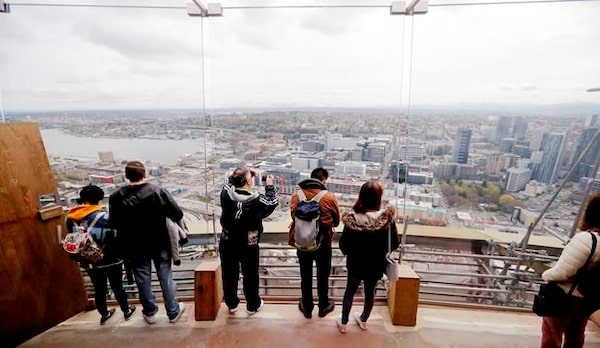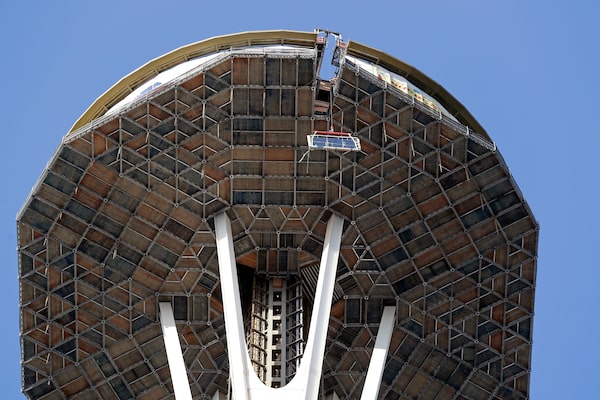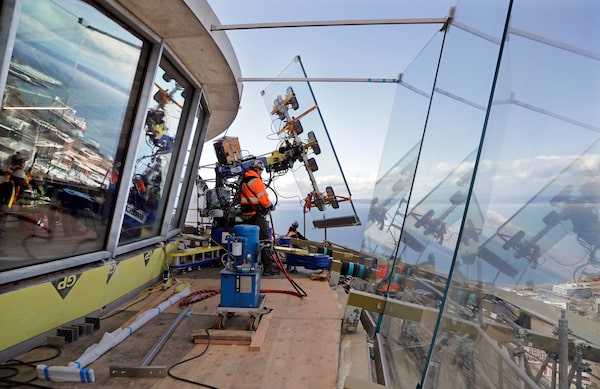
Space Needle visitors look east through newly-installed glass panels to Seattle below. The landmark has undergone its biggest renovation in its 56-year history, a US$100-million that transformed the structure's top viewing level.Elaine Thompson/The Canadian Press
Vancouver architect Michael Geller has seen some remarkable buildings around the world during his decades-long career. Most recently, he visited Astana, which is home to the newly built Bayterek Tower.
The structure is 97 metres tall, its height representing the year 1997, when Astana was named Kazakhstan’s capital. At the top is a golden sphere surrounded by pointed spires, a reference to a local folktale about a bird that lays its egg in the sacred tree of life, a story about new beginnings and finding happiness.
“It looks like an egg caught in the branches of a tree,” says Mr. Geller, president of Geller Group and adjunct professor at Simon Fraser University’s Centre for Sustainable Development in Burnaby, B.C. “One of the focal points of that city, like so many cities in the world, is this tower; it was one of the first things they built. It’s got a lot of symbolism.”
Although the Bayterek Tower doesn’t hold any world height records, it attracts and inspires Kazakhs and visitors alike, with an observation deck within its golden orb that allows people to see a modern-day, master-planned city within a region steeped in history.

The extensive renovations to the Space Needle in Seattle had to pass through the city’s Landmarks Preservation Board to ensure the recognizable profile wouldn’t be altered.Elaine Thompson/The Associated Press
“Even going back to the Middle Ages, towers were seen as a symbol of prestige and power, and I think that that tradition has continued over the centuries,” Mr. Geller says.
The current world title for the tallest skyscraper goes to Dubai’s Burj Khalifa, at 828 metres. But it will be knocked off its throne in 2020 when the kilometre-high Jeddah Tower opens in Saudi Arabia. In this age of escalating heights, there’s a push in North America to keep existing towers relevant, to ensure their significance isn’t reduced.
Take the Space Needle in Seattle. Last year, its owners announced extensive multiyear renovations to preserve and update the 184.4-metre-tall tower, which was constructed for the 1962 World’s Fair.
The US$100-million first phase is nearly complete, with slanted floor-to-ceiling windows and an outdoor observation deck featuring open-air glass walls and glass benches. Two interior observation levels will be connected by a striking wood, steel, and glass staircase, the lower level being the world’s only rotating glass floor, meaning you can stare down the tower itself all the way to the ground. Look out and you have 360-degree views of the city and Puget Sound.
Karen Olson, Space Needle chief marketing officer, notes that the upgrades all had to be approved by Seattle’s Landmarks Preservation Board. This was to ensure that the tower’s profile wouldn’t be altered, given its instantly recognizable profile with its saucer-shaped top.

A 900-kilogram glass panel is moved into position on the Space Needle's observation deck in Seattle. The landmark has new floor-to-ceiling glass in the observation deck and its restaurant has been remodelled in the first phase of the renovation.Elaine Thompson/The Associated Press
In addition to the need for physical and electrical upgrades, a driving factor for the enhancements was to keep the Space Needle’s status and significance entrenched. Nonresidents know it as a tourist attraction, but to the people of the Emerald City, it’s much more.
“We wanted to ensure it’s just as relevant in 2062 as it was in 1962,” Ms. Olson says of renovations that are being called the Century Project. “When it was built in 1962 it was modelled after the Eiffel Tower, in that it really marks the skyline. Seattle in the late ’50s was a growing city, but we weren’t well-known at all. ... The idea was to put the city on the map.
“It’s a real identifier; it’s a symbol of the city,” she continues. “It’s also a symbol of the entrepreneurial side of the city, the innovation and ingenuity. When the Needle’s design was approved, they had no land, no funding, no permits; 400 days later it was built. It’s that can-do attitude; big ideas, big aspirations. Then from the city came Microsoft, Amazon, and Starbucks. It’s a physical symbol of the city but also a symbol of the spirit of the city, where anything’s possible.”
Canada’s most iconic structure, Toronto’s 553-metre-tall CN Tower, is also being refreshed, with a complete overhaul of its main observation level. New floor-to-ceiling glass window walls have been installed to open up views that stretch out to Niagara Falls and Rochester, N.Y. Multiple food hubs have replaced a single restaurant. There’s not one but two glass floors, with one on top of the other.
The tallest free-standing structure in the Western hemisphere, which was built in 1976 by Canadian National Railway and is now owned and managed by Canada Lands Co., has had technological upgrades as well, most notably the implementation of a viewfinder app that allows people to create a kind of virtual reality on their mobile devices. Accessibility has been improved, too, with wider spaces that are easier to navigate.
The refreshed CN Tower remains a popular tourist destination, attracting a record 1.98 million visitors last year.Andy Clark/Reuters
Neil Jones, vice-president and chief operating officer of the CN Tower, looks to social media as one way to get a sense of CN Tower’s place in the city and in people’s minds. “Some of your biggest feedback is on Instagram and Twitter daily,” Mr. Jones says. “When people are flying in to Toronto, they see the tower lit up and they say, ‘I’m home.’ It’s a home beacon to them. It really resonates with the people of Toronto.”
To connect with people across the country, the tower is illuminated on any given night in different colours to support various events or causes, from Canadian Football League and National Hockey League victories to National Aboriginal Day, Canadian Forces Day and health-related awareness campaigns; some nights, two organizations are recognized by the tower glow.
“You’ve got to stay relevant,” Mr. Jones says. “You have to be updating constantly and building the guest experience. We don’t want to rest on what we’ve done in the past but look forward to where we’re going.”
It seems to be working. Last year, the tower experienced its busiest year on record, with approximately 1.98 million visitors. The CN Tower not only marks the Toronto skyline but has also become a symbol of the entire country.
“In the old days, if I wanted to know what people thought was important about their city, I would look at the postcard rack in the tourist shops,” says Mr. Geller, the Vancouver architect. “If you look at postcard racks in Toronto, they still feature the CN Tower.”
The 50-year-old Calgary Tower, left, isn’t the biggest building on the city skyline but it remains relevant and, like other towers, plays ‘an important role in the architecture of a city,’ one observer says.Chris Bolin Photography Inc./The Globe and Mail
Mr. Geller notes that what distinguishes structures such as the CN Tower, the Space Needle and the Calgary Tower from office buildings that boast great heights — such as the Petronas Towers, twin skyscrapers in Kuala Lumpur — is that they’re open to the public.
“Some of the tallest buildings tend to be private; they don’t have observation decks so they’re not publicly accessible,” Mr. Geller says. “Many people can relate to the fact that you go into the lobby of a very tall office building and there, beside the elevator, is a sign that says, ‘No public viewpoint.’ ... And so for that reason these public towers continue to play an important role in the architecture of a city.”
This year celebrating its 50th anniversary, the Calgary Tower is wrapping up improvements to its observation deck and will soon unveil a new, immersive multimedia feature. The Olympic torch, which is situated at the tower’s peak, is lit during Olympic Games’ opening and closing ceremonies and anytime a Canadian athlete wins a gold medal. In 2014, exterior LED lights were added, allowing for the same kind of colourful acknowledgments that the CN Tower displays, whether it’s to cheer on the CFL’s Calgary Stampeders or to raise awareness of certain kinds of cancer.
“The lighting helps re-establish the sense of community the tower brings to the rest of the city,” says Calgary Tower president and chief executive officer Greg Guatto. “We’ve been investing in this property because we’re proud of it. Citizens of Calgary are proud of it. It really is right in the centre of the city, and you can see those lights from anywhere. If you watch Hockey Night in Canada, it’s always on the opening segment.
“It’s earned its spot of being relevant,” he adds. “It’s become an icon of the city skyline.”
The Burj Khalifa in Dubai is the world's highest skyscraper with a height of 828 metres. But it will soon be eclipsed by a kilometre-high structure in Saudi Arabia.MOHAMMED SALEM/REUTERS
With so much money being poured into modernizing and enhancing so many North American towers, luring people in — or rather up — is clearly the ultimate goal. The question may be: What continues to fascinate human beings about these types of buildings?
New, thrilling opportunities to stand on a glass floor high above the ground are a draw, particularly in an era when simply being up high in the sky is increasingly common. But a tower’s appeal may go deeper than that.
“Increasingly, a modernization or updating of these old towers involves creating glass floors and other things to offer an exhilarating experience,” says Mr. Geller, the Vancouver architect.
“I think in a sense, most of us want to fly. We can’t fly, but when you go up one of these towers, you do have the sensation of being like a bird and you get a perspective that you rarely get. In architecture, we do drawings that we call a bird’s eye view, and the thing about a tower is it gives you a bird’s eye view of a city.”